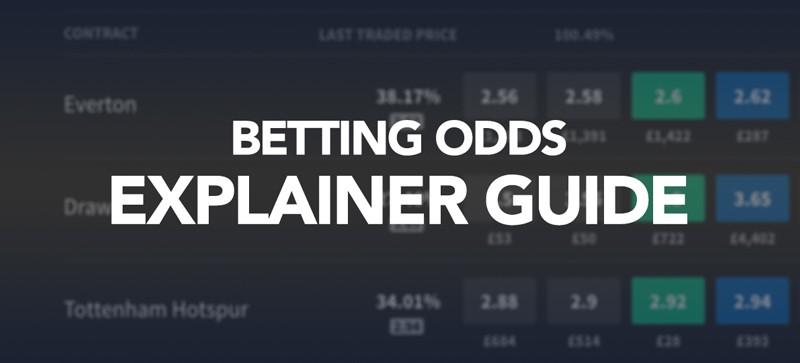What Do Betting Odds Mean
If you want to come out on top against the bookies it is vital that you understand the fundamentals. When it comes to sports betting there is nothing quite as fundamental as the odds that the bookies offer. Unfortunately, betting odds can prove very confusing. That’s especially true for people who are new to betting.
Reddit The magic number in sports betting is -110 because it defines the amount required by a sportsbook to earn $100 on either side of most wagers. A bettor must lay $110 to win $100 when wagering on point spreads, which are set by oddsmakers with hopes of.
Betting odds simply indicate the likelihood of an event and the return you’d get if you did make a wager on the result. Betting odds may be displayed in three different formats at US sportsbooks and online and mobile sports betting platforms: American odds, fractional odds and decimal odds. When you bet on the favorite you get worse payout odds on your bet since they’re more likely to win. The team with a negative number (like -110) is the favorite. The number next to the minus sign is the amount you must bet to win $100 in profit. If the number is -110, you must bet $110 to win $100.
- What do + and - mean in sports betting? The plus (+) and minus (-) in sports betting can refer to either the point spread or betting odds. In terms of the spread, the ' - ' always refers to the favorite and the ' + ' always refers to the underdog.
- Anytime you see odds with a minus in front of it, take the number and that is what you would need to bet in order to win $100 in profit. So, a -450 number would mean that you would have to bet $450 in order to win $100 in profit back. On the other hand, an odds number with a 'plus' in front of it means that the team or player is an underdog.
That’s where this article comes in. We’re going to explain exactly how betting odds work, how they are set and the differences in the ways they are displayed. After taking in all the information below, you will be much better equipped to set about making some profit.
What Do Betting Odds Represent?
At their most basic, betting odds tell you two things:
- How much you stand to make should the selection win
- The probability of the selection winning
Take this example. If you were looking through the weekend Premier League fixtures and saw a team had fractional odds of 2/1 (that’s decimal odds of 3.0) you would know that you stand to win £2 in profit from every £1 that you stake should the team win. You’d also know that the bookmaker who set the odds ranks the team’s chances of winning as one in every three times the game is played.
If you saw a team had fractional odds of 8/13, you’d know that for every £13 you stake, you will win £8 or profit and that if the game was played 21 times in total, the bookies think the team would win 13 times and fail to win eight times (what is known as the implied probability).
Working out an implied probability percentage from fractional odds is simple. You just divide the stake by the combined sum of the two numbers which make up the fractional odds. In the case of 2/1 the equation looks like this:
1 / (2+1) = 0.33 or 33%
For odds of 8/13 this is the equation:
13 / (8+13) = 0.62 or 62%
That’s how the maths works but when it comes to the actual odds that bookmakers set, it’s a little more complicated.
How Do Bookmakers Set Their Odds?
The basic business model of a sportsbook is fairly uncomplicated. Bookmakers set the odds and take bets on an event. When that event ends they pay out everyone who backed the winner and then keep the rest for themselves.
But, consider the following horse race.
| Selection | Fractional Odds | Decimal Odds | Implied Probability | Profit From a £10 Bet |
|---|---|---|---|---|
| Horse 1 | Evens | 2.0 | 50% | £10 |
| Horse 2 | 3/1 | 4.0 | 25% | £30 |
| Horse 3 | 7/1 | 8.0 | 12.5% | £70 |
| Horse 4 | 7/1 | 8.0 | 12.5% | £70 |
As you can see, the combined implied probability of the selections above is 100%. From a bookmaker’s perspective that is a big problem. That’s because, presuming they’ve got the same amount of liability on each selection, they’d never make any money as they’d have to collect and payout the same amount.
So, the bookmakers will build something called an overround into their odds. Here’s a real example of a match odds market from a football match:
| Selection | Fractional Odds | Decimal Odds | Implied Probability | Profit From a £10 Bet |
|---|---|---|---|---|
| Man Utd | 1/2 | 1.5 | 66.7% | £5 |
| Draw | 18/5 | 4.6 | 21.7% | £36 |
| West Ham | 13/2 | 7.5 | 13.3% | £65 |
With an total implied probability of 101.7%, the bookmaker who set those odds is guaranteed to make a profit of 1.7% assuming that they have the same amount of liability on all three selections. Of course, it rarely works out that the bookies manage to spread their liability evenly but you need to know that when you look at a betting market you’re not simply looking at a reflection of how the bookies think the event will pan out. There’s much more going on behind the scenes.
Armed with this knowledge of how the bookmakers set their odds, you can concentrate on finding value. That is, finding a bet where you believe the odds (and therefore the implied probability) is too big. If the bookies think that a side has a 50% chance of winning but you think they’ve got a better chance than that, that’s value.
The Difference Between Decimal and Fractional Odds
You will have seen above that we’ve spoken about both fractional and decimal odds. They are just different ways of conveying the same information but they do add another layer of complexity.
All the major online bookmakers will shows their odds as both fractions and decimals so it’s important that you understand just what they are showing and how to switch between the two. Thankfully, it only requires simple maths.
To go from a fraction to a decimal is as easy as dividing out the fraction and adding one. Here’s how that looks for odds of 2/1:
(2/1) + 1 = 3.o
And using our second example from above, 8/13, it looks like this:
(8/13) + 1 = 1.62
If you want to go from decimal odds to fractional odds is similarly simple. You just minus one from the decimal odds, turn that number into a fraction and reduce it down to it’s simplest form.
Let’s take decimal odds of 4.5, this is the equation:
4.5 – 1 = 3.5
35/10 -> 7/2

What Does +100 Mean In Betting
If the decimal price is 1.25, you convert it into fractional odds like this:

What Do Betting Odds Mean In Football
1.25 – 1 = 0.25
25/100 -> 1/4

Here’s a list of some of the most common fractional odds and their decimal equivalents (for a more in-depth list click here).

| Fractional Odds | Decimal Odds | Implied Probability |
|---|---|---|
| 1/10 | 1.10 | 90.9% |
| 1/5 | 1.2 | 83.33% |
| 2/5 | 1.4 | 71.43% |
| 1/2 | 1.5 | 66.67% |
| 1/1 (evens) | 2.0 | 50% |
| 3/2 | 2.5 | 40% |
| 2/1 | 3.0 | 33.33% |
| 4/1 | 5.0 | 20% |
| 9/1 | 10.0 | 10% |
| 100/1 | 101.0 | 0.99% |
Key Terminology
When reading betting advice or searching for a value bet on the bookies’ websites you’ll come across some key terms relating to betting odds. To round up our article on betting odds, we’ve covered the most widely used terms to ensure you don’t get confused in your search for winners.
Stake – The amount of money that you place (or wager) on a specific bet.
Price – The price of a bet is simply another way of referring to the odds. You can either say that a football team can be backed at odds of 2/1or that their price is 2/1.

Odds On & Odds Against – Two of the key terms that you’ll hear when it comes to betting odds are ‘odds on’ and ‘odds against’. These terms refer to whether a price is greater or lower than evens. Any price above evens is known as odds against, while anything below evens is odds on.
Short and Long Odds – If something is described as being short odds it means the price is low. A long odds shot will provide you with a bigger win but is much less likely to win.
The plus (+) and minus (-) in sports betting can refer to either the point spread or betting odds. In terms of the spread, the ' - ' always refers to the favorite and the ' + ' always refers to the underdog. For example, you can bet the Dallas Cowboys as a -7 point favorite to beat the Green Bay Packers or the Packers as a +7 point underdog. If you bet the Cowboys -7 and they win by more than seven points, you win your bet. Similarly, if you bet the Packers +7, as long as they lose by less than seven points or win outright, you win your bet.
It's a similar case for the betting odds, though favorites don't always have a ' - ,' especially in sports like baseball, hockey or soccer where final results are often decided by one run or one goal. It's especially the case in soccer since matches can end in draws, whereas a winner is declared in almost every other sport because of overtime rules. However, in most cases, the favorite will have a ' - ' in front of its moneyline odds while the underdog will always have a '+ .'
What Do Betting Odds -200 Mean
For an example of moneyline betting odds, you can bet the Eagles as a -150 favorite to win or the Giants as a +180 underdog to win. If you bet $100 on the Eagles to win at -150, you would net a payout of $166.70. If you bet on the Giants to win at +180, the payout would be $280 because they are an underdog.
What Do Betting Odds Mean Ufc
For something like soccer, Arsenal could be a +150 favorite against Everton as a +190 underdog, while the draw would be set at +220. In this case, the payout would be decent for every situation mainly because the teams are even and there are three possible results compared to just two for something like football (unless they go scoreless in overtime). In this case where both teams have a ' + ' in front of their odds, the team with the lower number is the favorite. The lower number also means a lower payout, which is always the case for betting the favorite on the moneyline. A $100 bet on Arsenal +150 would net $250, while a $100 bet on Everton +190 would net $290. Going further, a $100 bet on the draw at +220 would payout $320.